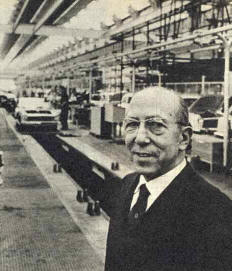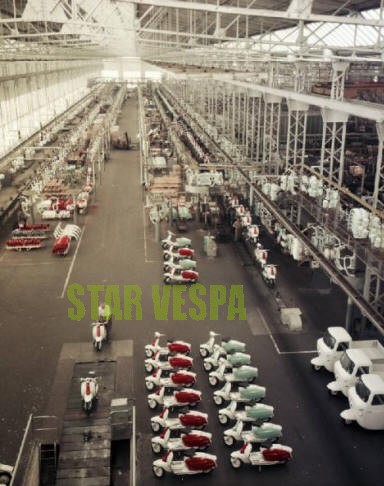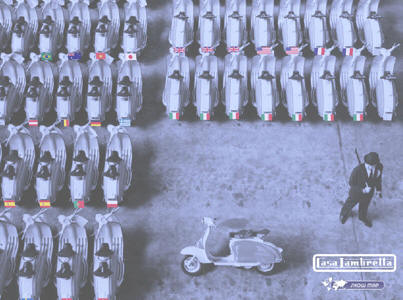LAMBRETTA HISTORY
FERDINANDO INNOCENTI: A SHORT BIOGRAPHY

Ferdinando Innocenti Ferdinando Innocenti was born in Pescia on the
1st September 1891. His father, Dante Innocenti, a blacksmith, soon
moved to the town of Grosseto, where he opened a hardware store in
Via Galilei, while continuing his activity as a smith. A few years
later a second store was opened in Corso Carducci. Ferdinando, after
having completed his 3rd year in a technical school, started his
activity with his father and his half-brother Rosolino (son of his
father’s first marriage) at the head of the "Ferramenta Innocenti"
(1906). Thanks to all the activities, at this time the family was
already well-off.
At 18, young Ferdinando was leading the family enterprise and
started trading iron mainly recovered from the firms engaged in the
drainage of the Maremma marshes. Iron was exchanged with oil, and
the oil sale gave high profits.
In 1920 he started experimenting the possible applications of iron
tubes and in 1923 he moved to Rome where he planned to invest about
half a million lire in the expansion of his activity. As luck would
have it, the Bank where his money was deposited went bankrupt after
a few months and Ferdinando was forced to slow down and devote his
time to recover the large sum of money.
Despite this misfortune, Ferdinando was not discouraged and soon
started to trade the Mannesmann seamless steel pipes produced by
Dalmine. 1928 saw a boom in the building sector and the economic
situation in Italy was flourishing. Agriculture was also growing,
thanks to the policy of the fascist regime and the consequent
disappearance of the trade unions’ activity. A negative outlet of
the governement policy was however a 11-12% decrease in wages
between 1921 and 1924.
From 1921 to 1931 the fascist regime set out a great plan of
building and remoderning, particularly in the capital. During this
decade, Rome looked like a huge builder’s yard and the general mood
was the "monumental renaissance of the city". Ferdinando seized the
opportunity and in 1926 he opened in Via Porto Fluviale a tube
storage warehouse and plant where he made products for the building
activity. The "Fratelli Innocenti", as the company was called in
1930, started producing tube scaffoldings in 1933. The British
Scaffolding’s mounting-dismantling special rapid system was applied.
In 1931, Ferdinando started building a plant of rain irrigation in
the Castelgandolfo Pope’s Gardens (14 hectares). The water was
supplied by lake Albano. Immediately after, he worked on a similar
plant for the Vatican Gardens, and then he completed a fire-fighting
and a thermoelectric plant. He also used his scaffolding patent for
the Cappella Sistina, where he had the opportunity to show the
quality of the project: the scaffolding was assembled and dismantled
in a very short time, and without interfering with the priceless
Michelangelo’s wall paintings. Franco Ratti count of Desio, a nephew
of Pio XI, and Leone Castelli, owner of a building enterprise
working in the Vatican, were providential in allowing Ferdinando to
take part in the project of the Cappella Sistina. The project was
concluded by the end of 1935 and at the beginning of the following
year Ferdinando was charged to mount a 6,000 square metres wide
covered complex with his tubes for the world exhibition of the
Catholic Press.
The firm obtained contracts of great prestige, which not only helped
transform the artisanal enterprise in an industrial company but
gained to it more profits which contributed to its enlargement. In
1932 the industrial production recorded a 27% decrease if compared
to 1928, but Ferdinando Innocenti decided Milan was the right spot
to move into with his activity. The city was in fact very active,
the Central Station was then being built, and the economic crisis
was not as bad as elsewhere. In northern Italy, Innocenti had a
privileged position and won many contracts. In 1929, because of the
serious crisis, 300,000 people were recorded as being out of work,
and they increased to more than one million in 1931, 715,000 of whom
in the industrial sector.
With the help of Ratti who was then in the Dalmine’s Board of
Directors and had also important positions in other companies, and
especially with the help of his Vatican friendships, Ferdinando won
contracts for works in the Vatican Castelgandolfo. The seat of
Fratelli Innocenti was then officially opened in Via S. Paolo 18.

The 20 workers of 1929 were more than a hundred in 1931, when the
company started the production of mobile and fixed irrigation
plants. The factory in via Pitteri (Milano Lambrate) was built in
1933. Here, the now tested Innocenti scaffoldings were produced and
traded. A new plant was built in October 1933 on a strip of land
between Via Pitteri and the Lambro. To start production, a number of
workers moved in from Rome.
In November 1933 the name of the company changed into "Fratelli
Innocenti Societ� Anonima per Applicazioni Tubolari in Acciaio". The
main seat was in Rome, Via XX Settembre, the company’s assets 5,000
shares worth 1,000 Italian lire each. Of these, 3,100 belonged to
Ferdinando and 1,900 to Rosolino. To reach this sum the company
asked a bond loan worth 5,000,000 lire, split in 5,000 bonds worth
1,000 lire each with a 4% yearly interest. Sole Administrator,
Ferdinando Innocenti.
THE
SCENE
Italy,
more than any other country, is known for its motorscooters. In the
movies, a photograph of Rome, or in a story about this sunbathed
country, the motorscooters is an obvious feature in the Italian way
of life. The name most often mentioned when scooters are discussed
is Lambretta, and the story of this marquee is a study of the post
war industrialisation of Italy. The Lambretta, like many of its
European brothers, is locked up and interwoven with a parent company
that produces many other products in addition to its two-wheeled
vehicles.
It all began in Italy with Innocenti's first scooter, the Model (M)
rolled off the production line in 1947. The M went on to be known as
the Model A, and from then on the success of Lambretta grew and
grew. Who would have thought even today Ferdinando Innocenti and his
designers idea of getting Italy mobile after the war, would continue
to be a passion, way of life, and a mode of transport, even today.
At first Innocenti struggled to make it's scooter profitable, such
was the attention to detail and quest for perfection, but in the
early stages huge set up costs and small production volumes all
added to the overall costs of the machines. As time went on, the
factory became more and more modern, efficient and with each machine
production volumes rose quickly making the Lambretta a profitable
and viable product.
Innocenti's main market to start with was its home Italian market,
but they soon looked for new markets to expand sales and the word of
Lambretta. All parts of Europe soon began selling these small
scooters, and then most other parts of the world also saw the
Lambretta hit their shores.

Innocenti soon realised that by granting licences to manufacture
scooters to various countries around the world would not only allow
the Lambretta to be sold in more countries around the world, but
also saw them gain royalties from such ventures without capitol
outlay from the main factory itself.
Some of the countries around the world that seek licences from
Innocenti were, Spain, France, Germany, India, Argentina, Brazil,
Chile and more. Although some producers did market the Lambretta
under differing names, such as the Serveta from Spain, the
Siambretta from South America, they all share the family design that
came originally from Italy.
Many of these factories continued to produce Lambrettas long after
Innocenti close it doors. The Italian factory when it finally closed
it's doors, was sold to the Indian Government who set up S.I.L,
Scooters India Limited who continue even today to produce a version
of the Lambro three wheeled Vehicle.
The last two wheeled scooters to roll of the production lines of the
various factories was as follows -
Italy: Production ceased 1972
Spain: Production ceased 1989
India: Production ceased 1998
France: Believed to be 1958
Germany: Innocenti based products ceased in 1956, but the continued
for a few years under NSU Prima
South American: Not know, some factories still exist today, but
making cars
The Innocenti name is still used in Brazil.
STAR VESPA
24 hours Order: +84 9081 28158
Email: sales@starvespa.com
& starvespa@gmail.com &
support@starvespa.com
![]() +84 9081 28158
+84 9081 28158